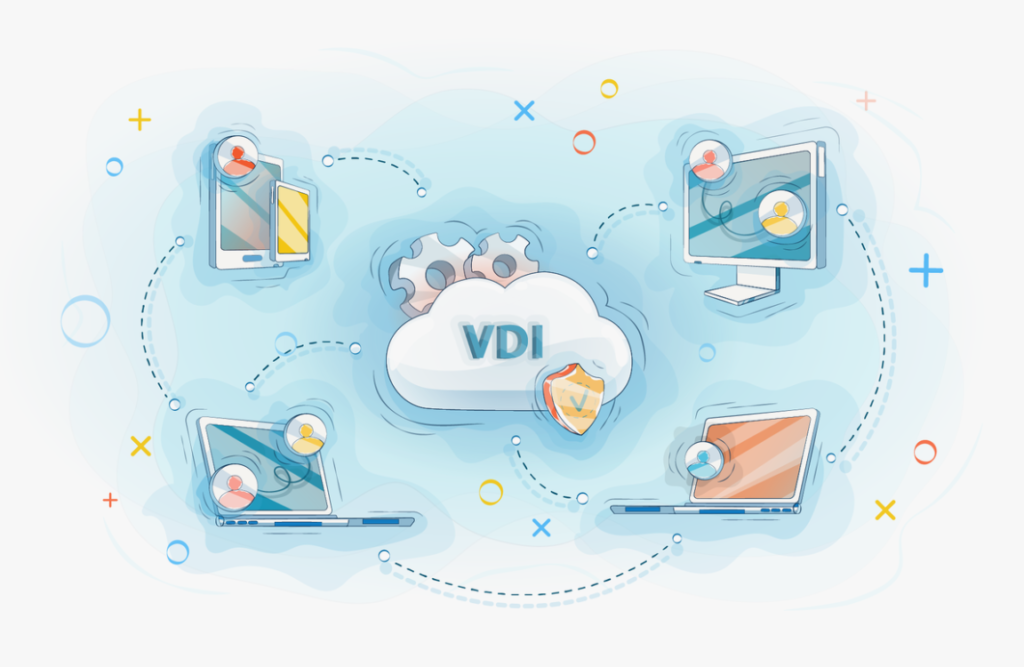
6 Best Practices for Securing Your VDI Infrastructure
Are you concerned about the security of your Virtual Desktop Infrastructure?
With more businesses embracing remote work and USINH VDI solutions, protecting these virtual environments has become more critical than ever.
A breach in your VDI can expose sensitive data and give unauthorized users access to your internal systems, putting your company at significant risk.
But how do you ensure your VDI is truly secure? In this article, we’ll dive into seven best practices to help you strengthen your VDI security
Let’s explore how to fortify your VDI infrastructure and ensure your team works in a secure and productive virtual workspace.
1. Implement Strong User Authentication
One of the most basic yet essential ways to secure your VDI solution is through robust user authentication. If you rely on weak passwords or single-factor authentication, you’re putting your entire system at risk.
Incorporating a strong authentication method like two-step authentication can effectively prevent 100% of automated attacks and 96% of bulk phishing attacks.
Weak authentication methods allow attackers to gain unauthorized access quickly. VDI environments, which host critical business applications, are prime targets for cybercriminals.
How to Secure Authentication:
- Use multi-factor authentication (MFA) to add an extra layer of security.
- Implement single sign-on (SSO) solutions to streamline user access while maintaining high security.
- Ensure that all users have unique, strong passwords that include a combination of letters, numbers, and symbols.
2. Use Network Segmentation
Network segmentation is another powerful method for securing your VDI infrastructure. It involves dividing your network into smaller segments and applying security policies to each segment. This limits the impact of any security breach and makes it more difficult for an attacker to access sensitive data.
Why It’s Important:
If one part of your network is compromised, network segmentation helps contain the threat. For example, your finance department’s VDI system should be isolated from your HR department’s VDI system to protect financial records and employee data.
How to Implement Network Segmentation:
- Segment your VDI environment into isolated zones based on roles and data sensitivity.
- Use firewalls to control access between network segments.
- Regularly audit your network to ensure there are no unnecessary connections between segments.
Network segmentation provides an additional layer of security that prevents lateral movement within your infrastructure.
3. Encrypt Sensitive Data
Encryption should be a non-negotiable part of your VDI security strategy. Sensitive data transmitted across the network or stored on virtual desktops needs to be encrypted to prevent data breaches.
Why It’s Important:
Without encryption, your data is vulnerable to interception during transmission or if attackers gain access to the system. This is especially important in VDI setups where multiple virtual machines share resources.
How to Encrypt Data:
- Encrypt all data at rest and in transit using secure encryption protocols.
- Use secure VPN connections for remote users accessing the VDI environment.
- Encrypt virtual hard drives (VHD) to protect data stored on virtual desktops.
Encrypting sensitive data helps ensure that even if attackers manage to breach your system, they won’t be able to access the data.
4. Regularly Patch and Update VDI Software
One of the easiest ways to improve the security of your VDI environment is by keeping your software up-to-date. Cyber attackers often exploit vulnerabilities in outdated software.
Do you know?
The virtual desktop infrastructure (VDI) market surpassed USD 19.6 billion in 2024 and is expected to grow at a CAGR of around 16.5% from 2025 to 2034
Unpatched software creates a potential entry point for attackers. Regularly updating VDI software and associated components helps close these security gaps before they can be exploited.
How to Keep Your VDI Software Updated:
- Set up automated patch management to apply updates promptly.
- Regularly check for security patches from your VDI vendor.
- Ensure that the underlying operating system and any software running on virtual desktops are also updated.
By keeping your software up-to-date, you significantly reduce the risk of attacks based on known vulnerabilities.
5. Monitor User Activity
Monitoring user activity is vital for spotting suspicious behavior before a breach occurs. By tracking login attempts, file accesses, and other actions, irregular patterns can be identified and addressed early.
Why It’s Important:
Monitoring helps detect threats like brute-force login attempts or unauthorized access, allowing quick action.
How to Monitor User Activity:
- Implement a logging system to track user actions.
- Use intrusion detection systems (IDS) to spot unusual behavior.
- Set up alerts for critical actions, like system changes or restricted data access.
Proactive monitoring ensures fast detection and mitigation of potential threats.
6. Limit User Access Based on Roles
Not all users need access to the same resources within your VDI solution environment. Limiting user access based on their roles ensures that only authorized individuals can access sensitive data and applications.
Why It’s Important:
Limiting access based on roles minimizes the risk of data exposure. If a user doesn’t need access to certain systems or data, there’s no reason to provide it.
How to Implement Role-Based Access Control:
- Use role-based access control (RBAC) to restrict access based on job roles and responsibilities.
- Regularly review and update access rights to ensure users have the appropriate permissions.
- Ensure that contractors or temporary staff only have access to the systems they need to perform their job.
By controlling access in this way, you ensure that only the right people can access sensitive resources, minimizing your attack surface.
7. Educate Users on Security Best Practices
Finally, one of the most effective ways to secure your VDI infrastructure is by educating your users. Humans are often the weakest link in security, so providing training can help prevent common security mistakes.
Why It’s Important:
Users can inadvertently compromise the security of your VDI environment through actions like clicking on phishing emails or using weak passwords. Training them to recognize and avoid these risks is essential.
How to Educate Users:
- Conduct regular security training sessions for all employees.
- Teach users to recognize phishing emails, suspicious links, and other common attack vectors.
- Encourage the use of strong passwords and MFA for all VDI access.
By educating users, you reduce the risk of human error and help keep your VDI infrastructure secure
Conclusion
Securing your VDI infrastructure is a multi-layered process, but by following these seven best practices, you can protect your organization from potential threats. From strong authentication and network segmentation to regular audits and employee training, each step plays a crucial role in creating a secure virtual desktop environment.
By continuously monitoring and improving your VDI security, you can ensure that your organization’s data remains safe, and your employees have a secure and reliable platform to work from. Follow these best practices and take the necessary steps to strengthen your VDI infrastructure.
Also read: 2U Rack Systems: Ideal for Small and Large Businesses






